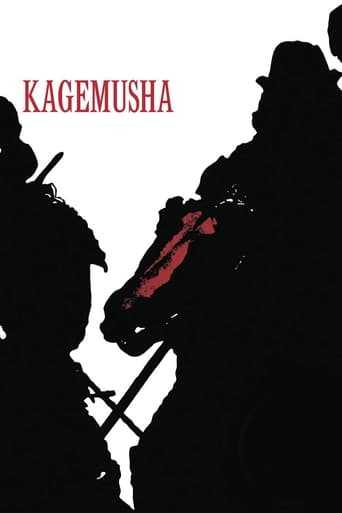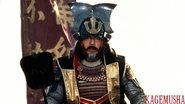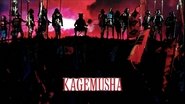diggus doggus
I think you, viewer, and reader of this review, should avoid Kagemusha.Here is why.I'm a long standing fan of Kurosawa, and i consider Rashomon and Shichinin no Samurai two of the greatest films ever made; Kagemusha, is a very, very different beast.First off, it's a three hour marathon. I grew up in the 70s and 80s and it was not uncommon for directors to write cinema-quality films that lasted for five or six hours, which would then be serialized on TV. But to stomach the whole of these 187 minutes, it takes the most hardcore film snob.The main story is of, Toshiro Mifune (which has carried the brunt of Kurosawa's work), here as a lowly thief who is at the right place at the right time. He looks just like a local lord who has just died, so they put him in place as Kagemusha, or "stunt double". There is an opposing clan (the Oda/Tokugawa alliance) which wants to attack them, but they are scared of the lord's tenacity.Now, this film has tons of fantastic acting, superb touching moments from Mifune, as he changes - like his character does - from thief into feudal lord, more and more adapting to the role within the role.But it's also three bloody hours.See, the issue here is that the classic "hero" solution cannot work; this is a historical piece and Mifune's character must fail, despite how much we root for him. This not only leads to disappointment, but also sets the film's needs for lengthy and complex developments of the background, rather than focusing on the character arcs, such as 7 Samurai does.And this is why i have a hard time recommending Kagemusha to the viewer. It's a documentary interspersed with some character drama, but if you are not prepared to watch over two hours of medieval troops marching, i suggest you give this a miss. It's a shame because with some solid editing you could get a 1-hour film of great class; but then again maybe a re-write would be better.8/10 - it might be a masterpiece, but it's not a FILM masterpiece.
Leofwine_draca
This is Akira Kurosawa's penultimate historical epic made before his last such film, RAN, in 1985. Kurosawa is best known for his string of successful samurai flicks made during the 1950s – the likes of SEVEN SAMURAI, THRONE OF BLOOD, and HIDDEN FORTRESS which have wowed critics and audiences alike for the last half century. KAGEMUSHA, THE SHADOW WARRIOR is a film that sometimes recaptures those glory days but for the most part is a lesser cousin to those classic works. Where films like SEVEN SAMURAI were epic in every sense of the word, the only thing epic about KAGEMUSHA is the running time, which is seriously overlong. This means that there are quite a few slow-paced scenes which add exposition, detail, and character so only the most patient viewers need apply.Yet this isn't the biggest problem with this flawed film. The major issue is the budget, which ran out before production was complete, meaning that George Lucas came in to supply funding when Toho lucked out. In the end, this provides Kurosawa with the biggest joke of all: he's made a war film without any battle scenes, except he tricks us into thinking he has. He shoots a major incident during the night, relying on some excellent sound effects to recreate the noise and feel of warfare; my favourite trick is the use of a flickering red and blue back screen to simulate the burning of a castle. Even at the climax, we only hear and then see the aftermath of a huge, decisive battle.The good news is that these things aren't too much of a problem, because at heart KAGEMUSHA is a character piece, all about the guy who pretends to be Shingen. Tatsuya Nakadai takes the duel role of warlord and stand-in, and he's frankly excellent; the finest element of the film. He crafts a believable character, a man living his life as a lie, and his development from a petty thief to a man who really believes that he's Shingen himself is spellbinding. It helps that he's supported by a great cast, all of whom are adept at the official Japanese 'stony face' stance. Kurosawa's is a film of small, telling details and the fact that the whole thing is based on a true story makes what happens even more amazing. A mature, intelligent work of film.
riolama
This is the best movie I have ever seen. In any language from any culture. I thought so when I first saw it thirty years ago and I still think so now, despite not being able to see it in its original mind- blowing wide-screen form. It is not just one of the most visually beautiful films ever done. The positive reviews are all accurate, but many focus too much on Kurosawa in general rather than on the particular theme of this film, which is closely tied to Japanese history and ideals, and which unites all the specific beauties of text and technique. This is not simply a film about historical belatedness (a lament that the ancient idea of heroes is now exposed by the modern world to be a hollow fantasy, as Ebert and other suggest), or the Shakespearian tragedy of inevitable discrepancy between individual and historical role, as in Henry V), although the film includes something of these elements. It is more--a beautiful elegy to a positive feudal ideal of leadership that goes beyond individual power to sacrifice for country--embodied in the figure of Takeda Shingin. Great tactician, unsurpassed "rider" of horses and women, inspiring and fearsome military leader, he is also a student of the Sutras and a man who "stepped right into people's hearts," as one of his aides says. The opening scene shows he listens to criticism and has a sense of irony about himself; when the thief who is to play his "double" accuses him of being a murderer, he agrees but says he will do anything to unite the country in order to prevent endless war and bloodshed. The same actor plays the lord and his double with incredible depth and subtlety. Shingin is killed (by a gun) early in the movie; as he is dying he tells his generals not to let anyone know he's dead for three years--to let the thief replace him, so as to give the clan time to prepare for confrontation with the western- armed enemy--and, given that his clan is not armed with western firearms, not to move out of its own territory. The double or "shadow warrior" who takes his place begins to identify with the role and finds out that literal crucifixion (for theft) would have been nothing compared to the loneliness at the top where the weight of the world is on the leader's shoulders. Every moment of his existence requires that he sacrifice everything personal to a role that no one can ever fill perfectly, and that is now bereft of the one man who came closest to doing so. The kagemusha doesn't have Shingin's "riding ability" or his wounds or the depth of self-understanding to fill the lord's role and, when he cockily believes he can do so for a moment, he is discovered and thrown out. Neither he, nor any modern man trying to live an identity larger than himself--including the artist who, like the kagemusha, is creating a shadow of the ideal--can replace this feudal ideal which was superseded (literally, massacred at the end) starting over 400 years ago by Christianized and technologized decadence, represented by Nobunaga and Ieyasu. The kagemusha learns slowly, as we do, what the ABSENCE of the irreplaceable Shingin means to his people and symbolically to Japan. Many scenes build up as if to a great battle or political confrontation, and the generals keep the show going, but it is all hollow--the leader is gone. Shingin's ambitious and over-eager son then leads the Takeda clan out of the mountains--to a destruction by western technology reminiscent of Hiroshima and Nagasaki (especially since the historical battle was at a place named Nagashino). The point of the film is to show a lost ideal of the past which can never be regained and without which everything afterward is a shadow, like the kagemusha ("shadow warrior"). The double (like the artist) seems possessed with Shingen's ghost in the last scenes as he watches in horror while the son, in a self-centered Oedipal frenzy, destroys the flower of his people by moving beyond the legitimate limits of his territory and his scope, and the double can only throw a futile spear at the modern weaponry which destroys him. But a shadow identity from a meaningful past is better than none at all (Kurosawa shores these fragments against modern ruins at least as well as T.S. Eliot in "The Waste Land").
nightwolf517
I thought that it was very interesting to find out that this movie actually had problems getting the funds necessary to finish the film. George Lucas and Francis Ford Coppola helped convince 20th Century-Fox to fund the remaining portion of the budget in exchange for international distribution rights for Kagemusha. I thought it was neat how Kurosawa create huge battle scenes with little funding. He created the 'illusion' of a huge battle by showing scenes of marching soldiers, small clips of battle scenes, and sound effects. It is unbelievable that this film was so close to not getting produced because of the funding difficulties. I am very happy that this film got the funding it needed.













